Introduction
- The dynamics of acculturation and biosocial communication receives increased attention in modern literature.
- Key Concepts:
- Culture – organized pattern of values beliefs and behaviors.
- Ethnicity – “shared values behaviors and customs as well as patterns of thinking and feeling that distinguish one cultural group within a given society from another” (Robbins, Chatterjee, & Canda, 2012, p. 138).
- Majorityand minority – groups of unequal power, where one group is subordinate to the other.
- Stereotype – an overgeneralized and rigid definition of group characteristics assigned to people of a certain group.
- Discrimination – actions of a dominant group that harm the subordinate group.
- Ethnocentrism– believing that one’s ethnic group is superior over others.
As the United States has become more racially and ethnically diverse in recent years, the dynamics of acculturation and bicultural socialization in the lives of ethnic and racial minorities has received increasing attention in the literature. The issue is that older theories of culture change have proven to be inapplicable universally. Therefore, the need for more advanced approaches to the interpretation of intercultural relations has appeared.
However, before delving into details about such theories, it is vital to appreciate key concepts. The chapter identifies six central ideas that are crucial for intercultural relations theories.
- Culture refers to the organized pattern of values, beliefs, and behaviors developed and transmitted over time by a social group.
- Ethnicity is very close to the concept of culture and includes shared values behaviors and customs as well as patterns of thinking and feeling that distinguish one cultural group within a given society from another.
- Majority and minority are groups of unequal power, where one group is subordinate to the other.
- Stereotypes are overgeneralized and rigid definitions of group characteristics that is assigned to people based on their membership in a group.
- Discrimination refers to actions carried out by members of dominant groups, or their representatives, that have a differential and harmful impact on members of subordinate groups.
- Ethnocentrism means considering one’s own ethnic or national group to be superior to others and using one’s own standards to evaluate all other groups.
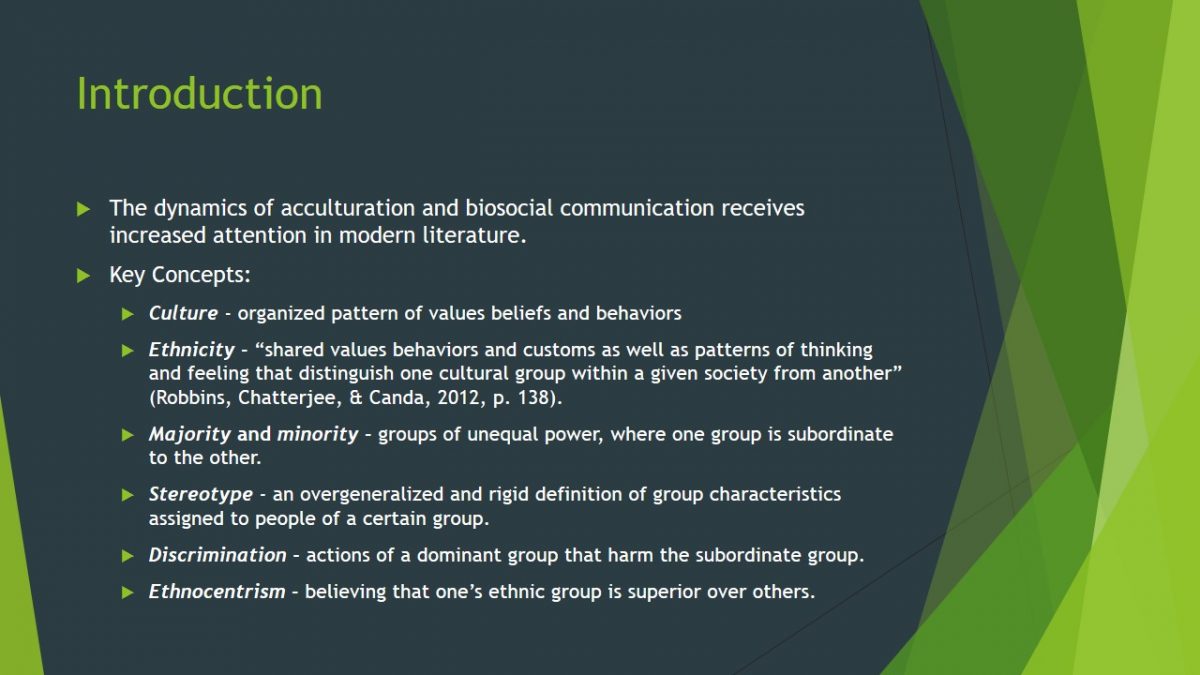
Assimilation Ideology
- Anglo conformity:
- Appeared in 1600s;
- Linear process;
- Culture of minorities changes to match the majority culture.
- Melting Pot Theory:
- Formulated by J. Hector St. John Crèvecoeur in the 18th century;
- “Individuals of all nations are melted into a race of new men” (Robbins et al., 2012, p. 135).
- Acculturation:
- Formulated by Horace Kallen as cultural pluralism in 1915;
- “Changing of one culture by incorporation of elements of another culture” (Robbins et al., 2012, p. 136).
Historically the process of cultural interaction was viewed from the stance of Anglo conformity. Anglo conformity is a belief base on the idea of the maintenance of English cultural patterns, institutions, and language was both desirable and necessary for colonists to prosper in the new world. The idea of Anglo conformity assumes that intercultural relations are a linear process leading to the disappearance of minority culture. In other words, minorities assimilate and embrace the values, views, and beliefs of the majority.
In the 18th century, Hector Crèvecoeur described another theory, which he named The Melting Pot Theory. According to Crèvecoeur’s idea, individuals of all nations are melted into a race of new men. America is seen as a new country were interactions of different cultures have led to the emergence of a new culture.
Later, in 1915, Horace Kallen described his theory of cultural pluralism, which is the cooperation of cultural diversities. According to this theory, during their interaction, two cultures acquire shared values and norms.
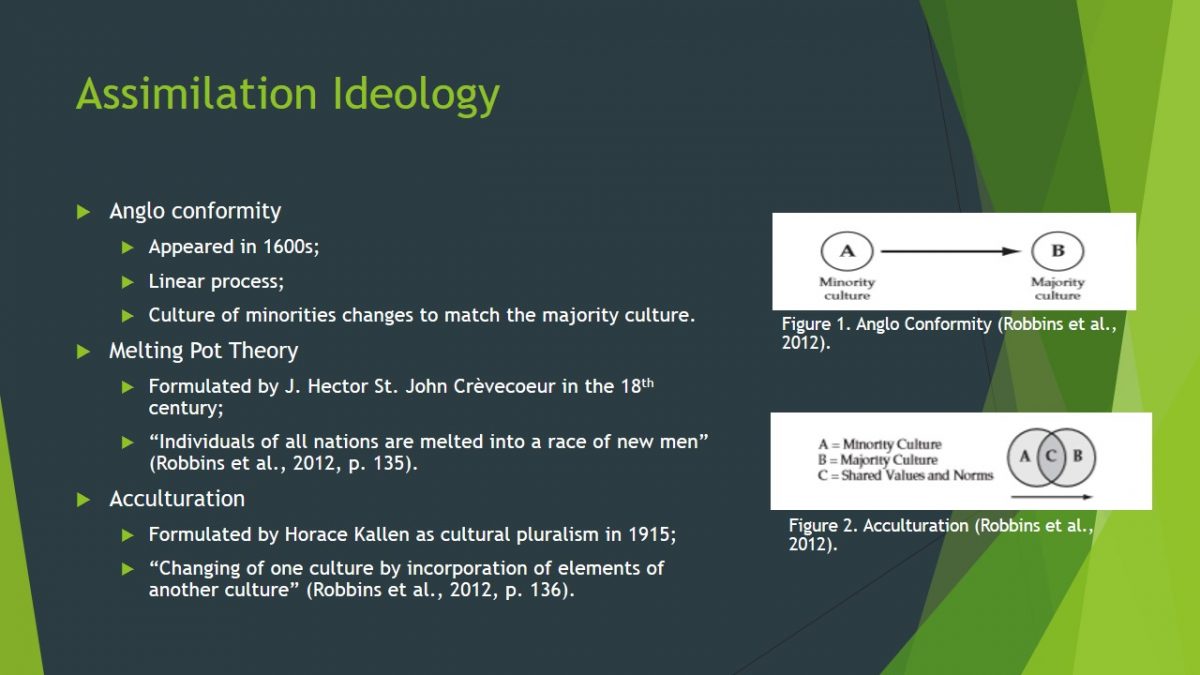
Deficiency Theory
- Emerged in 1900s, no identified founder.
- Cultural deficiency is a belief that some cultural attributes are the reason for being disadvantaged.
- Is applicable to explain low performance of African Americans and Latinos.
- Acceptance of Anglo-based norms to judge other countries.
- The theory leads to the idea of White privilege.
In the United States, all the cultural studies are based on the values of the researchers rather than on the norms of studied culture. Therefore, in the early 1900s, the theory of cultural deficiency has emerged.
According to this theory, attributes of minority cultures have prevented them from assimilating and attaining social mobility within U.S. society. The theory was widely used in the middle 1900s to explain the inability of minority groups, such as Latinos and African Americans, to become successful in the United States. The theory was accepted because it was based on Anglo values that dominated US society. However, the theory can hardly be called objective since it judges the behaviors, values, and norms of minority group members on criteria that are not likely to be culturally relevant.
The idea of cultural deficiency has led to the development of the concept of White privilege. The concept refers to social structural and interpersonal benefits and advantages given to White Americans of European descent based on their racial identification. However, it is a politically incorrect idea that is not appreciated by US society.
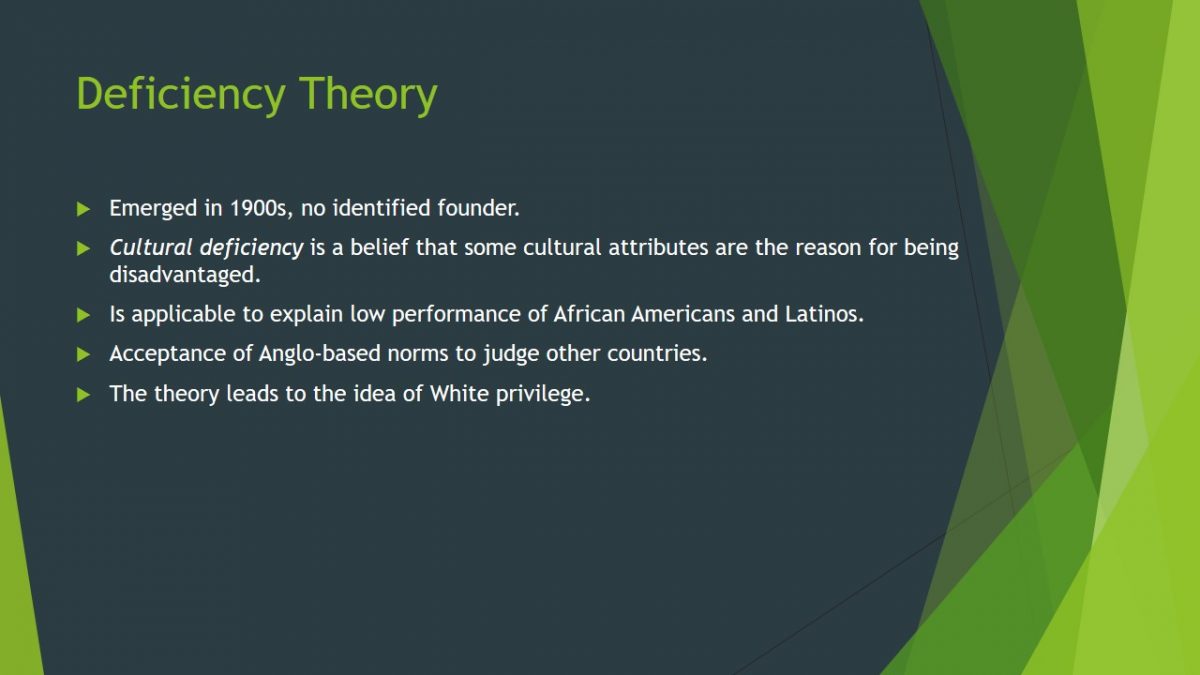
Dual Perspective
- Developed by Dolores Norton in 1978.
- Individuals are to be viewed in two systems:
- Nurturing system – individual, immediate family, extended family, immediate community.
- Sustaining system – political power, the educational system, goods and services.
- Human development is seen as a combination of cultural influences from both systems.
To more accurately understand the life context of minority persons, in 1978, Norton has suggested that they must be viewed within two separate contexts, the nurturing system, and the sustaining system. The nurturing system is the primary context and includes the individual, the immediate family, the extended family, and the immediate community. The sustaining system is the secondary context, or larger society, and comprises political power, the educational system, goods and services, and so on. Children are first raised in their primary context and then transition to the sustaining system. From a dual perspective, human development is seen as a combination of cultural influences from both systems. Therefore, a lack of congruence between majority and minority cultures should not be viewed as inherent deficits or pathology.
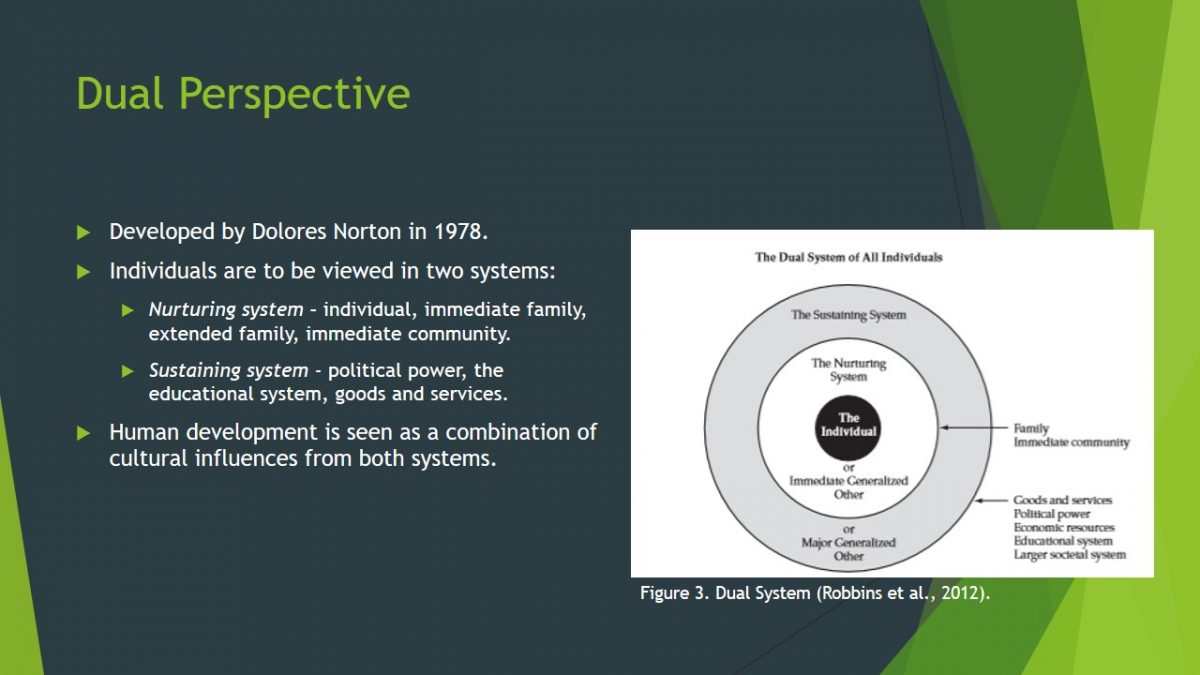
Bicultural Socialization
- Bicultural Socialization emerged in 1991 in the works by Chau, de Anda, and Ho.
- Allows family culture to be viewed as one that may operate independently from the larger societal culture.
- Bicultural conflict – occurs “when an individual’s family values and behaviors are different from those of the society at large” (Robbins et al., 2012, p. 144).
- Bicultural tension – inability to adapt to dual sets of demands.
- Bicultural conflict may lead to bicultural tension in members of minority groups.
Norton’s dual perspective gave rise to bicultural socialization that was first described in 1991 by Chau, de Anda, and Ho. According to this perspective, family culture is to be viewed separately from the larger society. According to this theory, conflicting cultural norms left minorities with a deficit in socialization. The deprivation of socialization was due to bicultural conflict and bicultural tension. Bicultural conflict occurs when an individual’s family values and behaviors are different from those of society at large. It can lead to bicultural tension, which is viewed as an inability to adapt to dual sets of demands. The ability to cope with the conflict depends on the level of support or rejection from both systems. A person is to have a clear and secure sense of self-identity to deal with rejection or criticism from the majority group. A person who successfully adapts to both cultures and languages can a new sense of power emerges from these adaptive skills.
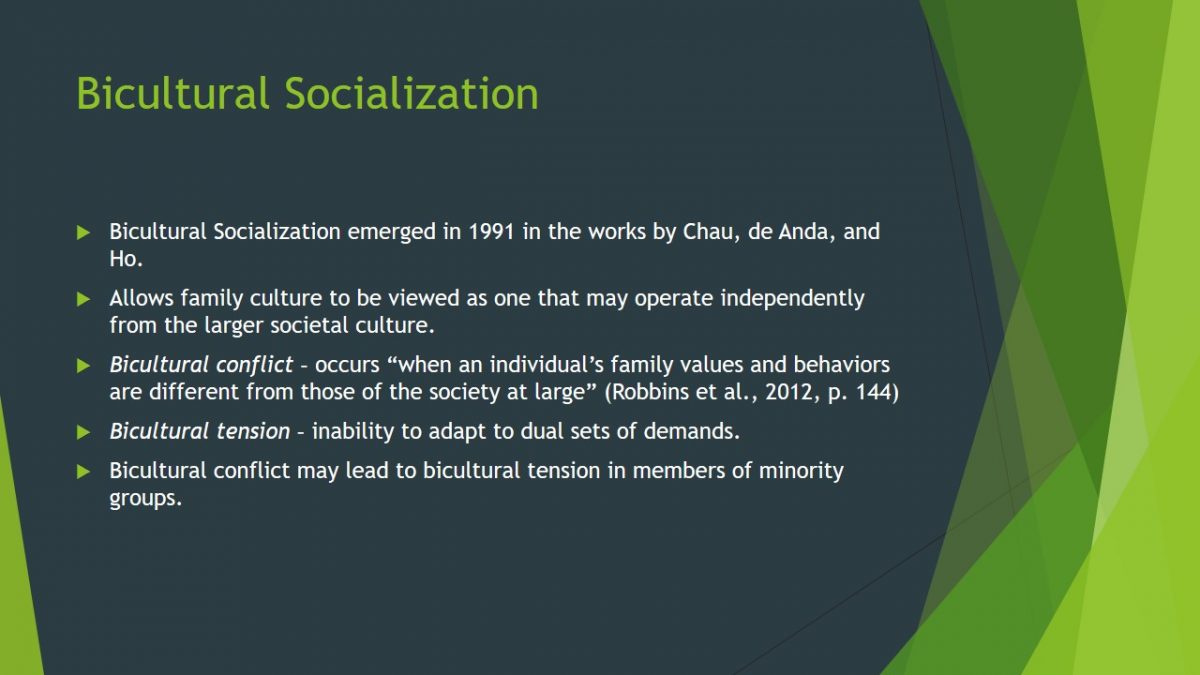
Ethnic, Racial/Cultural, and Minority Identity
- Conceptualized by Cross in 1991.
- Minority groups develop in the context of oppression, racism, and marginalization.
- There five stages of acquiring a positive ethnic or racial/cultural identity.
- Pre-encounter.
- Encounter.
- Immersion-emersion.
- Internalization.
- Internalization-commitment.
Even though the idea of ethnic, racial/cultural, and minority identity has been around since the 1970s, it was conceptualized by Cross in 1991. The concept views the development of minority within the broader cultural and historical context of oppression, racism, and marginalization of people of color in the United States. All members of minority cultures face prejudice, stereotyping, and discrimination.
According to Cross, there are five stages of acquiring a positive ethnic identity, including pre-encounter, encounter, immersion-emersion, internalization, and internalization-commitment. According to Cross, the process may first lead identity diffusion, typified by the rejection of the culture of origin and immersion in the majority culture. As the person grows older, she or he develops an awareness of the importance of primary group ties and becomes immersed in the culture of origin. Finally, the internalization of personal and group identity leads to the acquisition of positive ethnic or racial/cultural identity. The theory proposes that cultural identity clarity as being the primary factor that promotes psychological well-being in people who faced racism and discrimination.
The theory was revised by Helms and Cook in 1999. The researchers also described five stages, including conformity, dissonance, immersion/emersion, internalization, and integrative awareness. Similar to
Cross’model, the final and most sophisticated stage is one in which the person develops a positive racial self and is able to integrate aspects that may be characteristic of other groups as well.
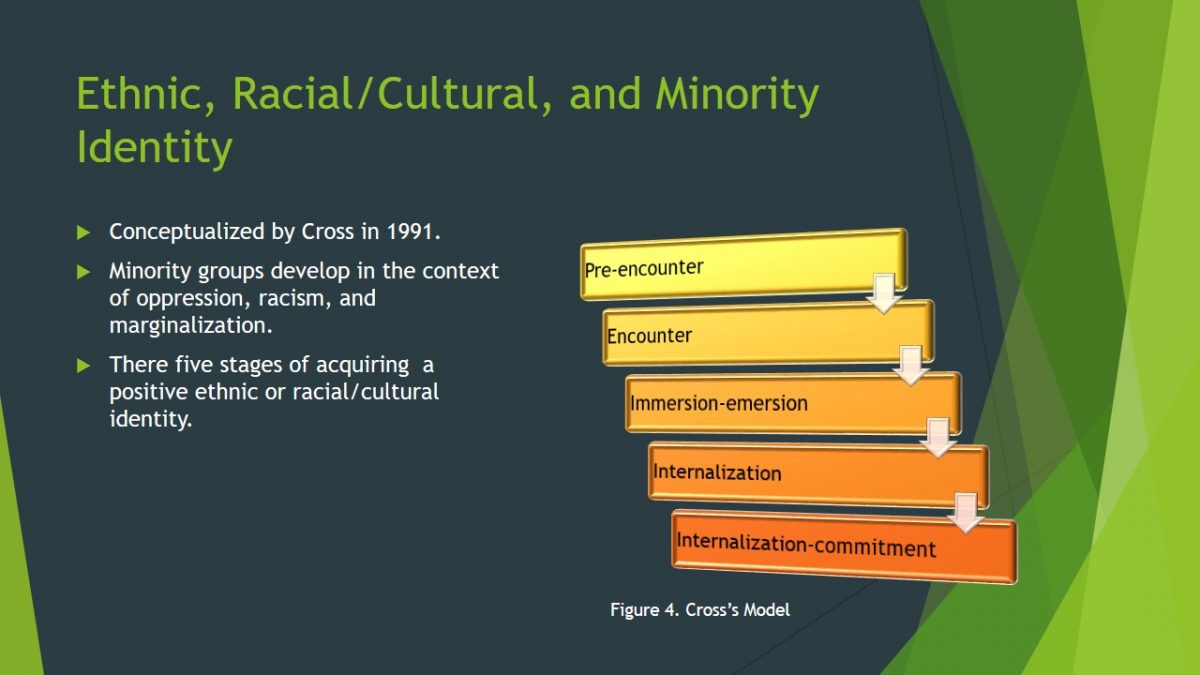
Multidimensional Transactional Model of Culture Change
- The multidimensional model incorporates all the concepts described previously.
- Galan proposed the multidimensional model in 1990.
- Four types of adaptation:
- Marginal;
- Traditional;
- Assimilation;
- Bicultural;
- Social class depends on the level of adherence to social norms of the majority culture.
- Two-dimensional model is insufficient to understand the complexity of the theory.
- Three-dimensional model helps to appreciate the dynamics.
- Three-dimensional model shows that a bicultural person may move between types of adaptation.
In order to acquire a greater appreciation of the life of minorities, it is vital to understand ethnic identity, the dual perspective, the dynamic nature of bicultural socialization, the existence of bicultural conflict and bicultural tension, and the contextual nature of cultural adherence. Therefore, in 1990, Galan proposed a multidimensional model that can be seen in Figure 5. This model describes four types of adaptation.
Marginal adaptation refers to minorities that failed to adapt to either nurturing and sustaining systems. Such people experience culture conflict, and since they are unable to deal with the conflictual demands of the two systems, they end up rejecting the norms and values of both.
Traditional adaptation describes a strong commitment to family values that are usually present in the first generation of ethnic minorities and new immigrants. In its nature, traditional adaptation is high adherence to the values and behaviors of the ethnic family culture, and low (or absent) adherence to values and behaviors of the society.
Assimilation is the rejection of family norms in favor of the majority culture. Such adaptation usually happens in younger minorities after being educated in a new culture. Such people may feel pressured to drop their cultural values and behaviors to survive the perceived or actual discrimination of being ethnically different.
Bicultural adaptation, or acculturation, refers to minority persons with a strong bicultural orientation who have high levels of adherence to both nurturing group values and behaviors and sustaining societal values and behaviors. As seen from Figure 5, the social class often depends on the level of adaptation to the norms of the majority culture. Therefore, assimilated and acculturated individuals are more likely to be financially successful in life.
Galan’s model is a three-dimensional model since two dimensions are no not enough to describe the process of bicultural adaptation. A three-dimension model represented in figure 6 helps to appreciate the dynamics of the process. It helps to picture how values and behaviors of one person change through time. Some situations, such as those at the workplace, may require adapting and acting in more acculturated or assimilated ways, whereas other situations, such as those in family gatherings, may call for more traditional behaviors. Therefore, a flexible person is able to move from one type of adaptation to another depending on the circumstances and personal will.
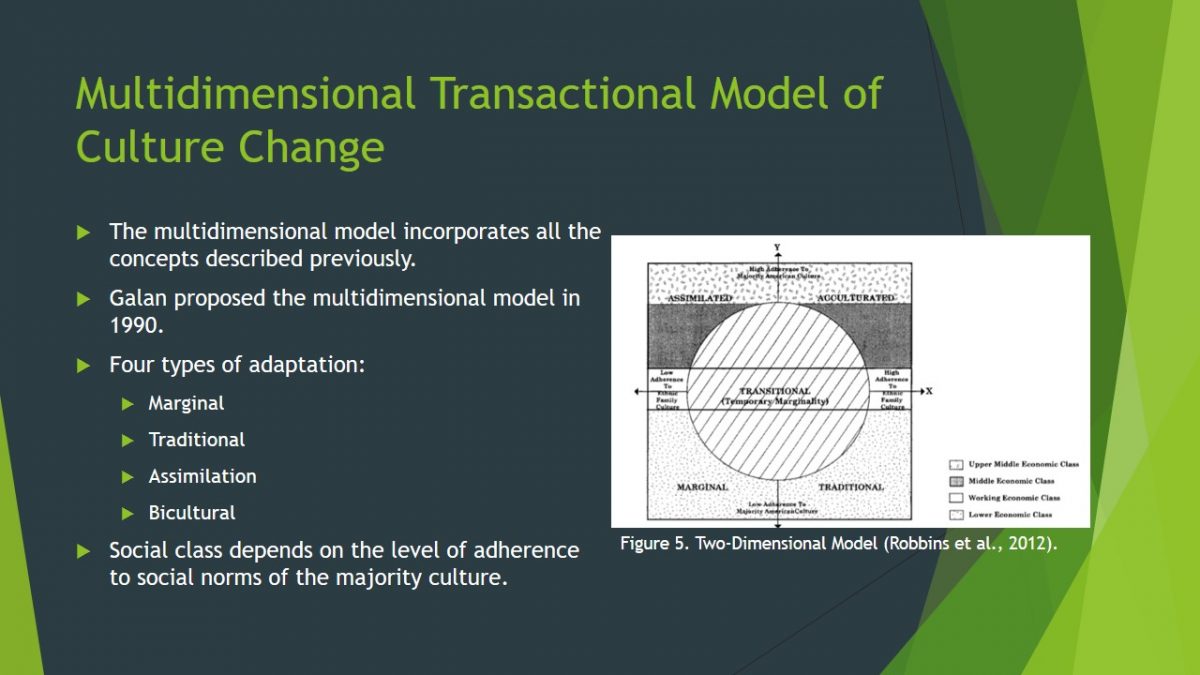
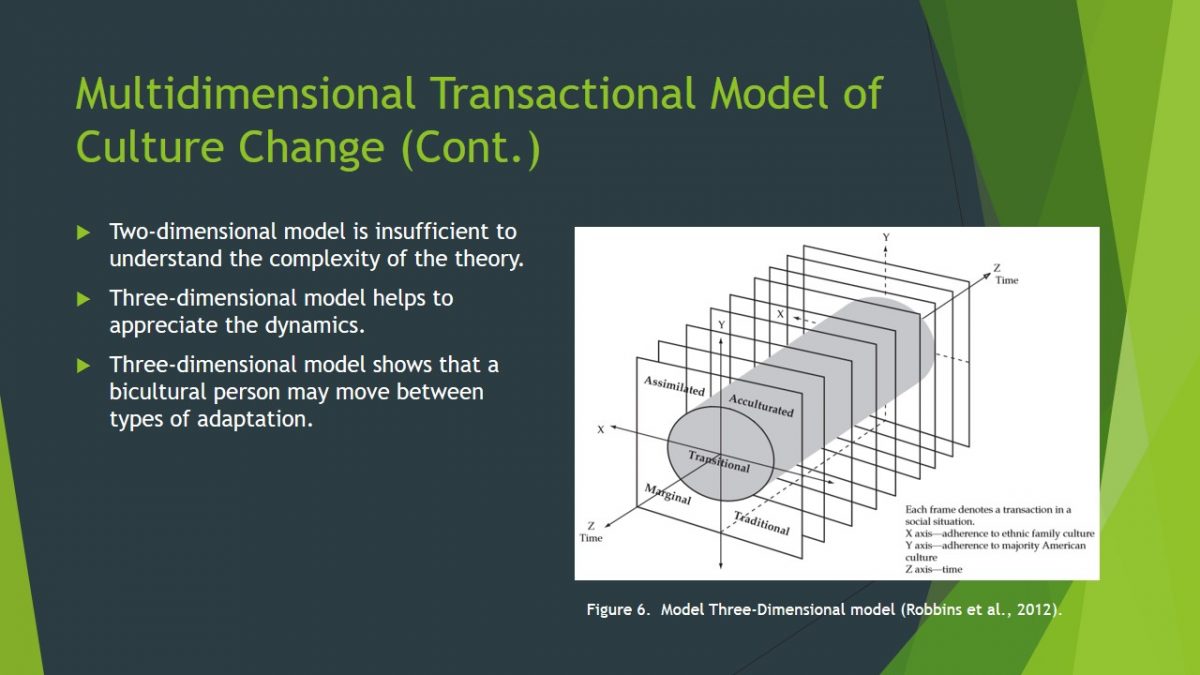
Theory Application
- Dual Perspective and bicultural socialization have found its use in social work practice:
- Definition of the helping situation;
- Assessment and practice strategies.
- Multidimensional model helps to understand:
- The problem of adapting to a new culture in critical growth periods such as adolescence;
- The issue of ethnic identity– and social role–related dilemmas;
- Intergenerational conflict caused by differential acculturation, including adultification and spousification.
While the theories are beneficial for understanding the process of cultural change, they are rarely used in research and practice.
Dual perspective, deficiency theory, and bicultural socialization concepts are currently used in social work practice. First, dual perspective and bicultural socialization theories help to identify the social issues of minorities. In particular, the theories help recognize if a bicultural conflict of bicultural tension is present by determining the values, behaviors, and norms of an individual. Second, these theories suggest technics for assessing the presence of support mechanisms in both the nurturing and sustaining systems. Such an assessment may define deficiencies and help to use an efficient strategy to address the problem. For instance, in order to be effective, the person must include a care provider into the nurturing system. At the same time, the theories may suggest individual, family, organizational, or community interventions. Legislative advocacy may also be a focus of practice.
As for the multidimensional model, it is applied to research of conflict situations in bicultural families. First, the theory helps to appreciate the problem of adapting to a new culture in critical growth periods such as adolescence. The model suggests that transitioning to an efficient adaptation type may be delayed or hampered by age changes such as puberty. Second, the concept helps to understand the problems of adults transitioning to a new culture since they may lose their status. This may end up in a revision of family roles, which can weaken the support mechanisms. Third, the theory helps to understand the phenomena of adultification and spousification. Adultification occurs when a child assumes adult roles before adulthood. Spousification occurs when a child becomes adultified by the nurturing or sustaining systems.
Even though the applications of the theories are scarce, they have become an object of close attention due to globalization. Therefore, additional spheres of application may emerge in the nearest future.
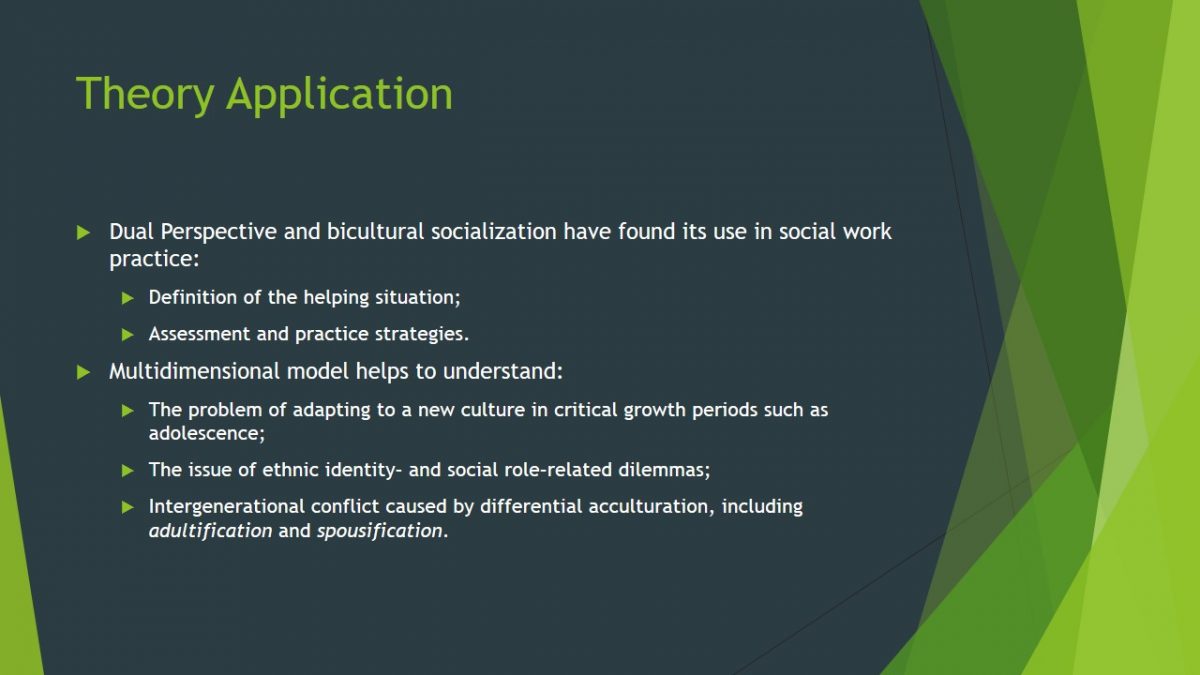
Application to Social Issue of Interest
- Research question: “What is it like to live through the experience of first-generation Latinos in transition from the military to civilian life?”
- Assimilation ideology based on Anglo conformity, melting pot theory or acculturation are inapplicable to my research question.
- Ethnic, Racial/Cultural, and Minority Identity can help to identify the stage of development and explain the problems.
- Deficiency theory can help to understand the failure to become prosperous and successful among veterans.
- Bicultural socialization theory helps to identify if bicultural conflict and bicultural tension had an impact on the experience of veterans.
- Multidimensional transactional model of culture change can help to understand the events in veterans’ lives were affected by adaptation type.
- Dual perspective model can help to identify how supporting mechanisms from nurture and sustaining systems helped to cope with problems.
Theories are valued for their applicability to specific research questions. The question of my present research is “What is it like to live through the experience of first-generation Latinos in transition from the military to civilian life?” Not all the concepts reviewed today can play a role in the social problem of my choice.
Assimilation ideology based on Anglo conformity, melting pot theory or acculturation are inapplicable to my research question. The reason for that is they have be proven to be generally deficient. They are usually used to understand the historical background behind modern theories.
Ethnic, Racial/Cultural, and Minority Identity can help to identify the stage of development and explain the problems. However, I believe that this theory is hardly beneficial for my research question, since it represents a linear process. Modern theories are more flexible and have the ability to understand social issues with greater accuracy.
While deficiency theory can help to understand the failure to become prosperous and successful among veterans, it will not be applied to my research. I consider the theory to be racist and unethical.
In short, all the theories gathered on this slide are of little importance to my research question.
Bicultural socialization theory helps to identify if bicultural conflict and bicultural tension had an impact on the experience of veterans. It would help to assess how the presence (or absence) of coping mechanisms with such conflicts have facilitated or obstructed positive outcomes.
Multidimensional Transactional Model of Culture Change can help to understand the events in veterans’ lives were affected by adaptation type. It would be the most appropriate framework for my research. However, the concept is overly complicated and it is rarely used in current research; therefore, it would be difficult to find relevant examples to replicate the approach.
Dual Perspective model seems to be the most convenient for my research question, since it is actively used in modern academic literature and the idea is straightforward. This theory can help to identify how supporting mechanisms from nurture and sustaining systems helped to cope with problems.
In summary, half of the approaches may be applied to the description of experiences of Latino veterans.

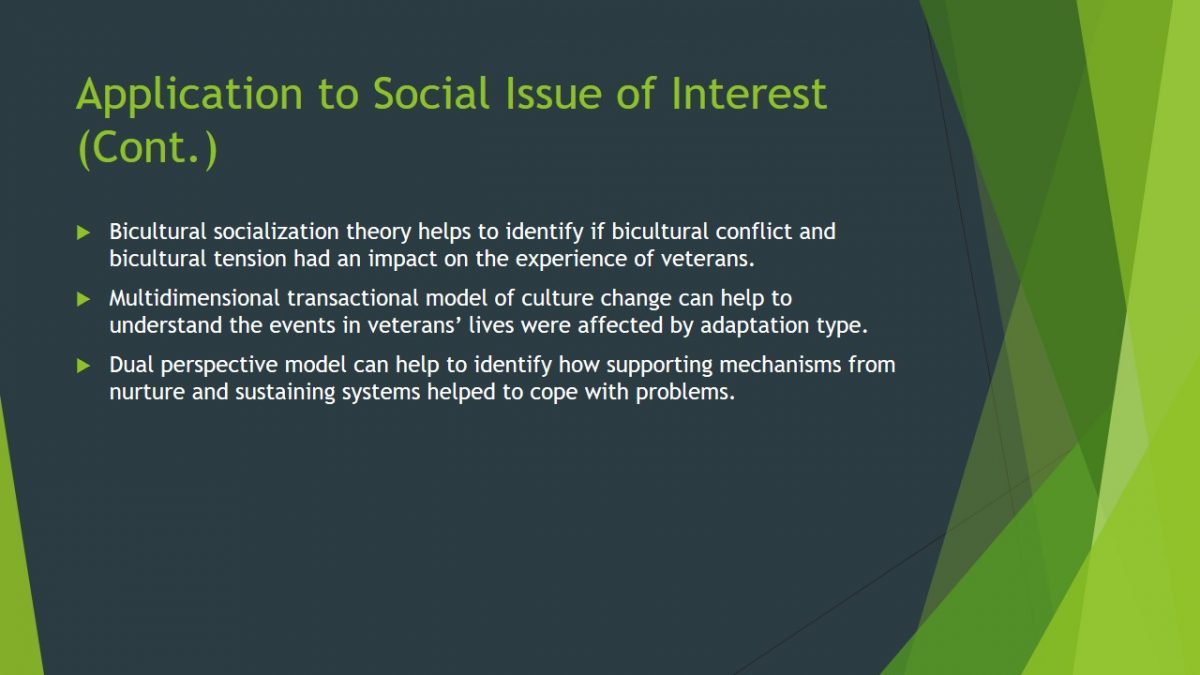
Conclusion
- Theories guide research and help to understand social phenomena.
- The reviewed theories are:
- Assimilation Ideology;
- Deficiency Theory;
- Dual Perspective;
- Bicultural Socialization;
- Ethnic, Racial/Cultural, and Minority Identity;
- Multidimensional Transactional Model of Culture Change.
- Most of the theories, excluding Norton’s Dual Perspective, are rarely applied to practice.
- Half of the reviewed approaches can be utilized for describing the experiences of Latino veterans.
Theories guide research and help to understand social phenomena of interest. The theories overviewed in Chapter 6 in the book Contemporary human behavior theory include Assimilation ideology; Deficiency theory; Dual Perspective; Bicultural Socialization; Ethnic, Racial/Cultural, and Minority Identity; Multidimensional Transactional Model of Culture Change. Most of these theories excluding Norton’s Dual Perspective, are rarely applied to practice. Half of the reviewed approaches can be utilized for describing the experiences of Latino veterans. However, for my research, I used the phenomenological approach to evaluate the opinions of individuals.

Reference
Robbins, S., Chatterjee, P., & Canda, E. (2012). Contemporary human behavior theory (2nd ed.). New York, NY: Pearson.